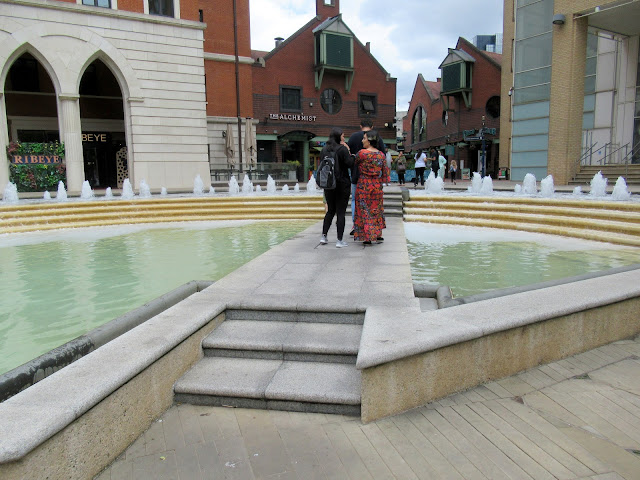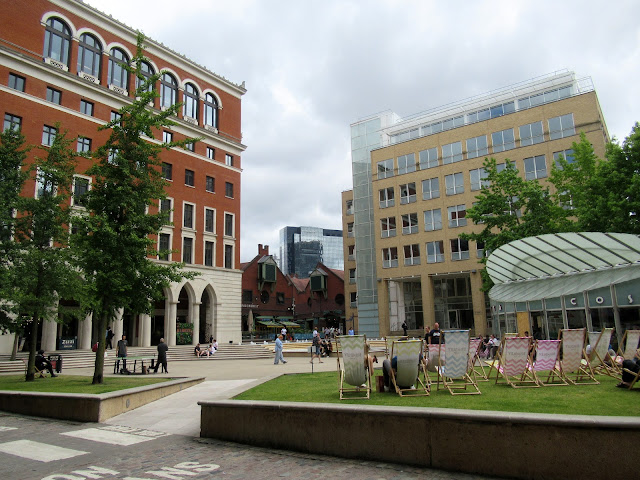Just beforce we came to Greece we went to Birmingham to see a painting by Artemisia Gentileshi which had been lent to the Ikon Gallery by the National Gallery.
Gentileschi, an Italian Baroque painter, one of the most significant artists of her age, initially worked in the style of Caravaggio. She was producing professional work by the age of 15. In an era when women had few opportunities to pursue artistic training or work as professional artists, Gentileschi was the first woman to become a member of the Academia di Arte del Disegno in Florence and she had an international clientele.
Her achievements as an artist were long overshadowed by the story of Agostino Tassi, her painting tutor and friend of her father, who raped her at 17. She endured a scandalous seven-month trial in which she was tortured to 'prove' she was telling the truth - a torture device/lie detector made of metal and rope, was tightened around her fingers but she continued to repeat 'it's true, it's true'. In the end she was believed, and Tassi deemed guilty - but, being a favoured painter of the Pope, never actually ended up serving a sentence. She worked as an artist in Florence, Naples and finally London. For many years she was regarded as a curiosity, and her art was not given the recognition it deserved, as is the case with so many women artists, but her art and life have been re-examined in the 20th and 21st centuries.
Many of her paintings feature women from myths, allegories and the Bible, including victims, suicides and warriors. There are 57 known works by Gentileschi and 49 feature women as protagonists or equal to men. Her characters intentionally lack the stereotypical 'feminine' traits - sensitivity, timidity and weakness - they are courageous, rebellious, and have powerful personalities. Initially the interest in her work was focused on the rape trial, seeing the Judith and Holofernes paintings (she has painted six) for instance, as revenge paintings. Recent critics, see these paintings as stories of political courage and collaboration by two women committing a daring political murder in a war situation.
Gentileschi was the most famous female artist in Europe in the first half of the 17th century and, when in her twenties, made a series of self portraits in which she appeared in various guises. These may have served, in part, to promote herself and her work - as her success as a woman was unusual at the time. Gentileshi was aware of her worth: In a letter to a collector she declared: 'you will find the spirit of Caesar in this soul of a woman'.
A re-evaluation of Gentileschi's work has included a newfound appreciation of her technical skill, especially her command of chiaroscuro - a heightened juxtaposition of light and shadow.
Self Portrait as Saint Catherine of Alexandria by Artemisia Gentileschi (1615-17) at the Ikon Gallery in Birmingham
(Wrapped around Gentileschi's work and made as a direct response is a solo exhibition by Jesse Jones, titled Mirror Martyr Mirror Moon. I felt that this did not add anything to Gentileschi's work, found no value in it in itself, and furthermore, the fact that the gallery was in total darkness, (I actually bumped into somebody at some stage because you literally could not see anything except for the art) made it difficult to appreciate Gentileshi's work. So, I am not including anything about it in this post. It was just an irritation).
In this life-size painting, Gentileschi depicts herself as the early Christian martyr Saint Catherine of Alexandria, who was tortured for her beliefs by being bound to a spiked wheel which miraculously broke and left her unharmed. The artist uses a bold, closely-cropped composition and strongly directed light to focus our attention on the Saint herself, who was renowned as an intellectual.
Catherine's steady, resolute gaze,
her hand upon the wheel
and the martyr's palm she holds close to her chest make clear her sanctity and intelligence, as well as the sincerity of her convictions.
Gentileschi seems to have begun this painting, which was only discovered in 2017, without Saint Catherine's attributes. The menacing wheel, palm, halo and crown ornamented with pearls were added as the painting neared completion.
Three days after Birmingham we went to London to see
the 'Now You see Us' exhibition at Tate Britain.
It was such a coincidence and great pleasure to see that two paintings by Gentileschi were included in that exhibition. I include them in this post. At some stage I will write about the rest of the exhibition but I have no idea when, as I am so behind in my blogging - we have been doing too much and there is no time to write and post.
The first painting, Self-Portrait as the Allegory of Painting (La Pittura), I had seen before. It was exhibited at the Queens Gallery and we went to London especially to see it. You can see my previous post here
Self-Portrait as the Allegory of Painting (La Pittura), 1638-1639, (oil on canvas)
In this painting Gentileschi boldly used her own visage to embody the act of painting as a whole. She is shown conceiving the idea for a painting. As Riccardo Lattuada suggested 'it seems hard to imagine that Gentileschi, in making an image of Painting, did not reflect on the special significance this allegory held for her as a woman artist'.
In the painting she has abundant, mussed hair and plump cheeks, a brown apron tied around her waist and the billowing green silk sleeves of her dress pushed up past her elbows. Rather than looking out of the frame as is typical with self-portraits, the figure is looking at a prepared canvas, with a raised brush in one hand and a palette in the other. She bends forward, not elegantly but with the command of an experienced artist. As scholars have pointed out, no male artist could have attempted this clever visual doubling, in which Gentileschi combined a realistic portrait of herself at work with an allegorical representation of the art form that she so ardently and successfully pursued. In the painting she is accomplished, strong, original and contentedly absorbed in her vocation. Her portrayal of herself as the epitome of the arts was a bold statement to make for the period and was very controversial in its time.
The work was later purchased by Charles I of England.
Susanna and the Elders, 1638-1640, (oil on canvas)
The subject of this painting is an Old Testament narrative on virtue and faith. Susanna, bathing in privacy, is spied on by two elders who attempt to sexually assault her. When she resists them, the men accuse her of adultery. Susanna is arrested and about to be put to death until the men are questioned, and her innocence is revealed. Here, Gentileschi depicts Susanna as vulnerable and fearful, shielding her nakedness. She returned to the subject throughout her career, the first one was when she was seventeen.
Unlike other iterations, Susanna does not turn away from the two onlookers: she faces them and it could be argued that this Susanna draws the elders' attention away from her body not by blocking their gaze but by meeting it with her own - staring at them just as they stare at her, and obliging them to acknowledge her as a human being. Gentileschi's variations on the theme remain irresistible iconography, and her differing treatments of Susanna offer a forceful lesson about the power of the apparently powerless. Such tales of resistance remain as riveting, and as necessary, in the 21st century as they were in the 17th.
Though it wasn't an uncommon subject for artists at the time, Gentileschi rendered it differently than most. In her version, the woman being aggressed - and her response upon discovering that she's being watched - takes center stage. Gentileschi's Susanna presents us with an image rare in art, a three-dimensional female character who is heroic. Gentileschi's biographer Mary D. Garrard has explained that unlike other representations, 'the expressive core of Gentileschi's painting is the heroine's plight not the villains' anticipated pleasure'. Garrard notes that 'the painting represents an art-historical innovation: it is the first time in which sexual predation is depicted from the point of view of the predated. With this painting, and with many other works, Gentileschi claimed women's resistance of sexual oppression as a legitimate subject of art'.
You can see more of her work here




























































